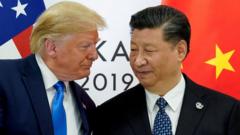In a recent address, Pan Gongsheng, the governor of the People's Bank of China, discussed strategies to reduce reliance on the dollar while highlighting the financial risks of a single-currency system, setting the stage for a contested global monetary landscape.
China's Central Bank Advocates for a Multilateral Currency System

China's Central Bank Advocates for a Multilateral Currency System
China seeks to challenge the dominance of the U.S. dollar in global finance, promoting its currency in a bid for economic influence.
During a speech at the Lujiazui Forum, Pan Gongsheng, governor of the People's Bank of China, voiced his concerns about the global financial reliance on one primary currency, presumably referring to the U.S. dollar. He stated that the oversights related to fiscal and regulatory issues in the nation issuing the world's main currency could lead to global financial risks and crises. His comments came amid a broader push from Beijing to diminish the dollar's stronghold over international trade and finance.
The dollar's decline this year, particularly against the euro by approximately 11%, aligns with discussions within the U.S. regarding potential currency depreciation to bolster exports. This situation raises concerns that while a lower dollar could enhance American trade competitiveness, it may simultaneously escalate government borrowing costs amidst an already increasing federal budget deficit.
Over the past years, China's efforts to internationalize its currency, the yuan, have gained traction as it attempts to present itself as a viable competitor to the dollar. By advocating for a multilateral currency approach, China aims to redefine the current financial landscape, which has historically given the U.S. significant economic power.
These developments suggest not just a pivotal challenge to the dollar’s dominance but also a shifting dynamic in global finance as countries look for ways to navigate an economy increasingly shaped by complex geopolitical factors.






















